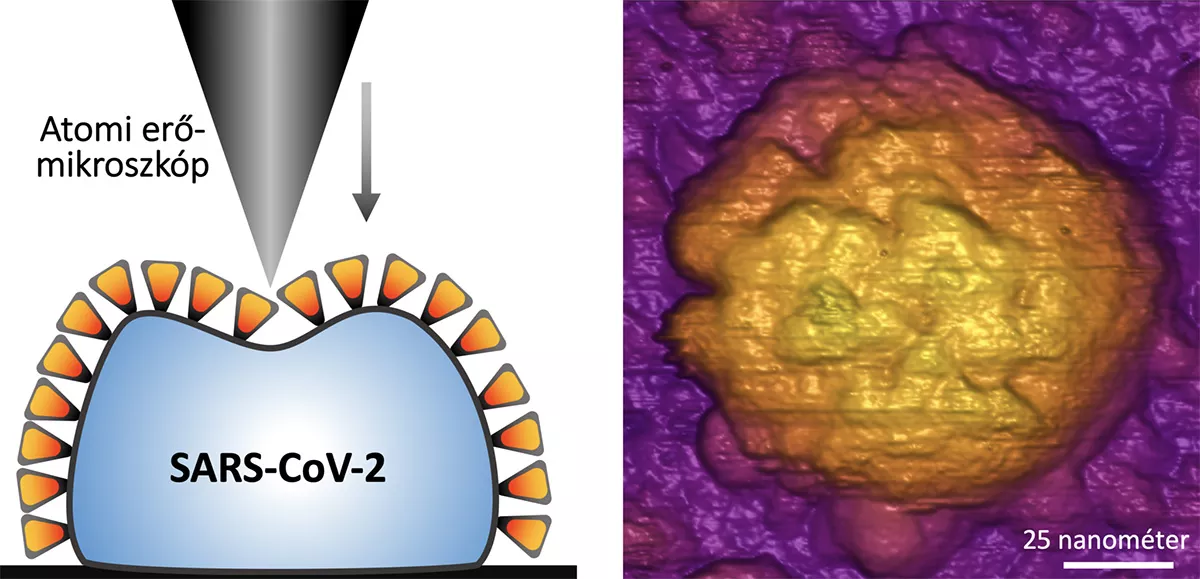Researchers from Semmelweis University, together with researchers from the National Security Laboratory of the Hungarian Public Health Center, are the first to successfully study the structure of an active and infectious coronavirus. According to their results, the crown-like spikes covering the virus are extraordinarily flexible, while the virus itself is capable of self-healing, which likely makes it one of the most resilient viruses known to humanity. Their study proved that the coronavirus is easily flattened, but then springs back into its original shape like a rubber ball, and physical impact to its structure does not cause damage. These factors may contribute to the unusually high infectivity of the virus.

Much has been discovered about the novel coronavirus (SARS-CoV-2) over the past six months, but there are still many unanswered questions regarding its properties and how it functions. With this study carried out by researchers at Semmelweis University, however, we have come one step closer to better understanding this virus: Dr. Miklós Kellermayer, Dean of the Faculty of Medicine at Semmelweis University (and a member of ELKH's Governing Body) led the research group, including researchers from the National Security Laboratory of the Hungarian Public Health Centre, in examining the structure of the coronavirus. They were able to probe the surface of the SARS-COV-2 virus using an atomic force microscope. The probe revealed that the crown-like spikes covering the virus are extraordinarily flexible and the virus is uniquely resilient: it can be easily flattened, but then pops back into its original shape like a rubber ball, but this physical impact does not cause damage to its structure, nor its substance. According to Dr. Miklós Kellermayer, the mechanical and self-healing properties of the virion may allow it to adapt to a wide range of environmental conditions, which may also contribute to its particularly infectious nature.

This study by researchers at Semmelweis University is unique because research results published up until now were based on examining inactivated, chemically treated or frozen samples of the virus. Dr. Miklós Kellermayer and his research group, however, examined active and infectious coronavirus samples, which was made possible with a protocol designed for its specific measurement along with the use of an atomic force microscope (AFM).
This microscope is used to study the topography and nanomechanical properties of atoms, molecules and cells. The method was developed by Gerd Binning and Heinrich Rohrer, earning them the Nobel Prize in 1986. According to the Dean of the Faculty of Medicine at Semmelweis University, the AFM is the only microscope capable of capturing high resolution images of native pathogens because the particle does not need freezing or fixing, as it would with an electron microscope.
To examine the approximately 80-nanometer-wide SARS-CoV-2 virus, the researchers pierced it with an even smaller needle. They pushed the needle in from top to bottom, flattening the virus. As soon as the needle was removed, it sprang back into shape. They repeated this process 100 times on the same sample, but the virus remained almost entirely intact. This supports the hypothesis that SARS-CoV-2 may be one of the most physically resilient and resistant viruses known to humanity.
The researchers of Semmelweis University and the National Security Laboratory of the Hungarian Centre for Public Health also examined other structural properties of the virus. Viruses generally become vulnerable after leaving the host. However, SARS-CoV-2 may well persist on surfaces for a long time while maintaining infectivity. The study suggests that the flexible spikes covering the particle may contribute to this factor.
Results of previous studies differed on the number of crown-like spikes covering the outer surface of the virus. A study at the University of Cambridge counted around 24 spikes, while the Max Planck Institute in Germany estimated around 40. The virus examined by Hungarian researchers in this study had 61 spikes. According to Dr. Miklós Kellermayer, this may also prove that the structure of the virus is much more versatile than previously believed.
The proteins constituting the spikes were also closely examined. On physical impact from the needle the crown-shaped spikes started vibrating at such high frequency that the AFM, capable of taking 300 images per second, could only capture blurry images. The researchers suspect that this rapid movement enables the virus to find and connect to host cells more easily.
The heat resistance of SARS-CoV-2 was tested as well. The researchers discovered that its general appearance was barely altered even after being exposed to 90°C (194°F) for ten minutes. The virus lost a few spikes, but remained structurally intact. This might help explain why it remained highly contagious despite the summer heat or in countries with warmer climates.
Ádám Szabó
Source: semmelweis.hu